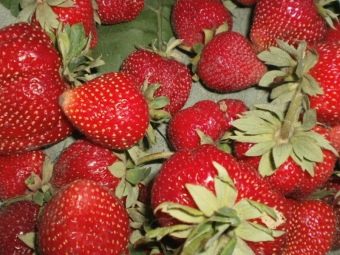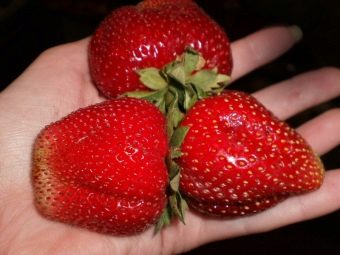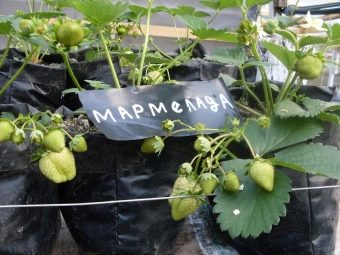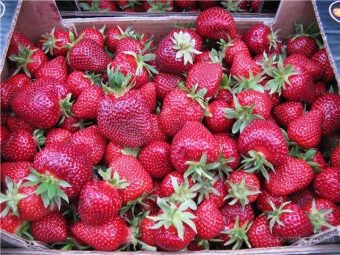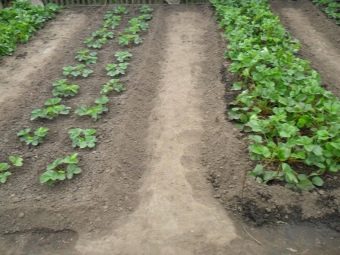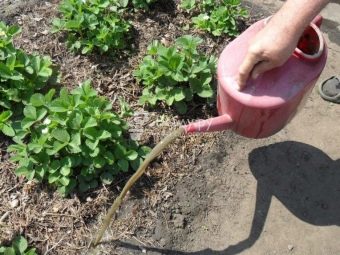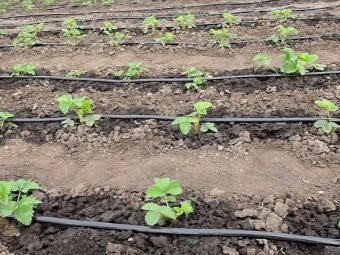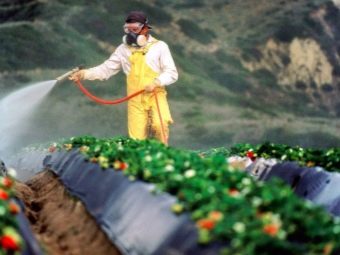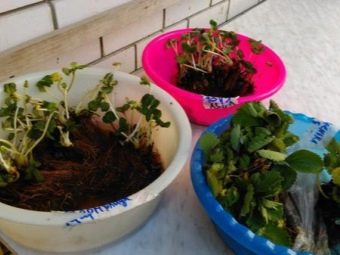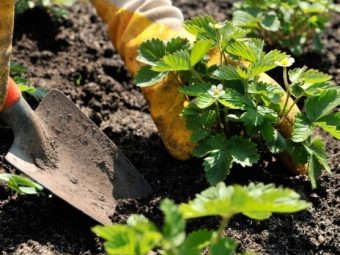Strawberry "Marmalade": variety description, cultivation and care
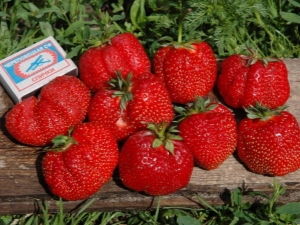
Strawberry is a tasty healthy berry. There are many varieties of it. Variety "Marmalade" receives from the gardeners rather contradictory estimates.Someone is delighted with the taste and the stamina of the culture, while others are completely disappointed in it. Therefore, it is worth trying to plant this berry and see how it will lead in specific climatic conditions.
Variety description
Strawberry "Marmalade" was bred in Italy more than twenty years ago. The unusual name arose due to the fact that the fruits in appearance and taste resemble marmalade. The characteristic of the variety contains information that “Marmalade” should bear fruit once a season. However, in warm regions, with good weather and good agricultural practices, in August the harvest may reappear. Therefore, experts call this variety semi-repair. Berry bushes have a small size, but are very resistant and strong. The leaves are quite large and painted in rich green color. As a rule, they are slightly elevated and tend in different directions. When the “Marmalade” starts the flowering season, it happens very abundantly: sometimes the flowers even hide the leaves.
The variety ripens relatively early: in the first weeks of June. However, the peak yield is in the second half of this month. In the case when after harvesting the leaves are immediately mown and the bushes are fed, in August or September it will be possible to re-enjoy the berries. Usually on one bush gardeners collect from 800 g to 1.2 kg, which is considered quite a decent figure. The mass of one berry varies from 20 to 30 g, and the maximum reaches 40 g. The fruits are rather large and have a standard shape: rounded, with a cone-shaped crown. The color of the berries is rich red, but the tip may be white.
The taste and smell of "Marmalade" is very good, and the sourness is insignificant.
This variety is not afraid of high temperatures. When other varieties dry up, “Marmalade” turns green, blossoms and produces berries that are no different in taste from those that appeared in normal conditions. The only thing that changes is the texture: the fruits are compacted and become drier. However, the culture reacts to excessive precipitation extremely negatively. When it rains constantly and there is not enough sun, the fruits cannot accumulate the right amount of sugar and achieve excellent taste. In addition, the probability of developing a fungus is high.
The ability to survive at low temperatures in this class is average. Strawberries can move and -30 ° C, but only on condition that there is enough rainfall. “Marmalade” has innate immunity to most diseases, for example, powdery mildew or verticellez, but very often it is exposed to gray rot, brown and white spots.
The variety has one peculiarity: when it comes to technical maturity, the fruits look great, are well stored and transported, but the taste is not so saturated. Fully ripened berries are slightly worse stored and look, but have a much more pronounced aroma and delight with more sweetness. Marmalade is successfully marketed, consumed fresh and used for numerous dishes.
However, it is believed that it is best to use it for freezing and drying.
Advantages and disadvantages
Variety "Marmalade" has bright pluses.
- Large size, beautiful appearance and pleasant taste.
- Strawberry fruits well.
- The variety does not require any special care from gardeners. The main thing is that the site was rather large and well lit.
- Culture in general is not afraid of high temperatures and lack of irrigation.
- The berries are well stored, they have a decent transportability.
Unfortunately, there are also disadvantages:
- the variety is completely incapable of normal development in conditions of cold and rainy weather;
- the variety can grow only on soils with neutral acidity;
- with a lack of moisture, the fruits darken, and with excessive plant thickening, they begin to decrease in size;
- "Marmalade" is subject to certain diseases.
Landing
If you are going to plant "Marmalade", first of all you need to make sure that the acidity of the soil is neutral. The beds are formed in such a way that between individual bushes remain from 25 to 30 cm. Between 18 and 20 cm are usually allocated for aisle. The beds are pre-digged, cleaned from residues of roots, weeds and other debris. In addition, it is important to introduce organic matter in advance.
The hole is dug quite deeply, since the roots of Marmalade are vertical. Fertilizers containing nitrogen, for example, humus, are immediately poured into the hole. The bushes themselves are treated with "Fundazol" to prevent the development of fungal diseases. In the case when the spine is too long, it is allowed to cut it from 6.5 to 7 cm. Strawberries are very carefully holed up: it is important not to overlap the “heart” level. Then the ground is crushed a little. The planting process is completed by watering, since it is important that the soil around the planting can go about 10 cm down. Ideally, the beds will need to be mulched.
According to the rules of crop rotation, strawberries cannot be planted where they used to grow eggplants, tomatoes and potatoes, which take all the nutrients from the ground. It is better to choose the following predecessors: beets and cucumbers, greens and carrots.
It is important to mention that if the soil is too acidic, it will need to be normalized by adding lime mortar.
Care
Typically, marmalade strawberries are fed with mineral solutions containing phosphorus and potassium. Not bad culture will respond to humus, weed solutions and other organics. Usually, before planting, peat and humus are introduced in an amount of 5–8 kg per 1 m2. At the same time, a solution of wood ash, superphosphate and cow manure is introduced. When the first sheets appear, the time comes for the urea solution. When the "Marmalade" blooms, then it has to be fertilized with potassium nitrate. Finally, in the first weeks of September, the beds are treated with superphosphate or potassium magnesia.
Irrigation should be regular, but not necessarily abundant.. The best option is to install a drip system. The temperature of the liquid used for irrigation cannot exceed 15 degrees Celsius, otherwise it will contribute to the development of gray rot. Watering always ends with loosening between rows to a depth of 8–12 cm. It is precisely between rows that are chosen, because close loosening will damage the roots. This procedure will allow to feed the root system with oxygen and scare away insects. We must not forget about weeding.
On the same plot of "Marmalade" successfully grows for three years, and then it will need to be transplanted. In the first year of strawberry development, she needs to remove the extra flowers: this will stimulate the root system. Before the winter months, the beds are mulched with stalks of straw or corn, and then the beds are covered with non-woven material.
Breeding
Since "Marmalade" produces a large number of whiskers, culture propagation is carried out without any problems. To get the bushes strong and resistant, you need to take only the first pair of sockets, which are formed on the mustache.
Diseases and pests
Most often, this strawberry variety is attacked by ticks, weevils and nematodes. The nematode is a small worm, the size of which varies from one to two mm. It rapidly multiplies and rapidly affects the plant. First, the leaves begin to curl and dry, and then the berries disappear.
If the fruits began to decrease in size and become covered with wrinkles, then a tick attack occurred. Typically, spraying 10–20 g of tobacco dust per square meter allows you to cope with this pest. In that case when the national remedy does not cope, "Malathion" is applied. Preventive measures include loosening the beds and fertilizing.If the tick has already attacked the culture, then get rid of it will turn out with the help of "Metafox" or "Phosphamide". Finally, the weevil harms strawberries. It is customary to fight it with solutions of onion peel, potassium permanganate or boric acid.
You can determine the attack of the weevil by the disappeared buds.
Gardeners reviews
About strawberries "Marmalade" gardeners leave a lot of feedback. People like that it is quite simple to take care of a grade, even beginners who are summer resident cope with the task. Judging by the comments of summer residents, it is impossible to form an unambiguous idea of the variety of “Marmalade” Some people praise him for enjoying both the taste and the yield, while others express dissatisfaction with the same moments. There is a tip that says that the berry is so popular with customers that they are ready to stand in line for the purchase. Her taste is sweet, the texture is juicy and moderately hard, and mild acidity only balances the excessive sugar content.
Also, “Marmalade” is loved because it is able to survive the hot summer months even with standard drip irrigation. If the pre-planting bushes before processing "Fundazol", then the disease should not be afraid at all. In addition, in the spring it is good to treat the beds with iodine solution before the beginning of the flowering period. Planting bushes is recommended quite spaciously, for example, according to the 45 cm by 50 cm scheme. As for fertilizers, it is advised to limit organic ones, which are applied three times per season. And of course, gardeners are pleased with the fact that at the end of summer we can expect a repeated harvest of large berries.
But at the same time there is a comment that "Marmalade" completely disappoints the taste, someone even compares it with tomatoes. Although the berries are large and attractive, their taste is so neutral that they can only be used in jams and preserves. In addition, the flavor is rather weak. Perhaps this is because the variety feels best in the southern regions, and in areas with a cool climate, it can no longer manifest itself.
To prevent the emergence of nematodes, you need to weed the beds in time, follow the rules of crop rotation, plant marigolds and calendula nearby and prepare the seedlings correctly. Before planting, the seedlings are lowered into water with a temperature of + 45 ° C for fifteen minutes, and then washed under cold running water with a temperature of 10–15 ° C.
Spraying with specialized solutions will help: “Phosphamide” or “Lindane” every five days. Usually several treatments help solve the problem.
For information on the characteristics of the strawberry variety "Marmalade", see the following video.


